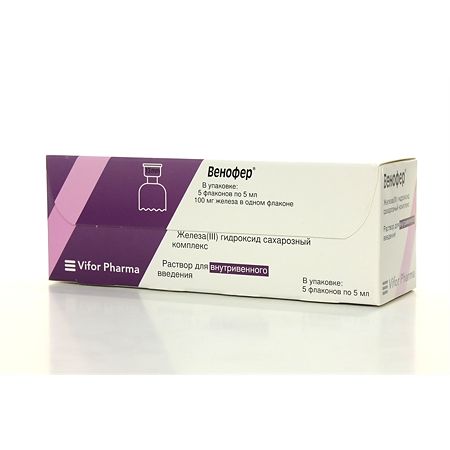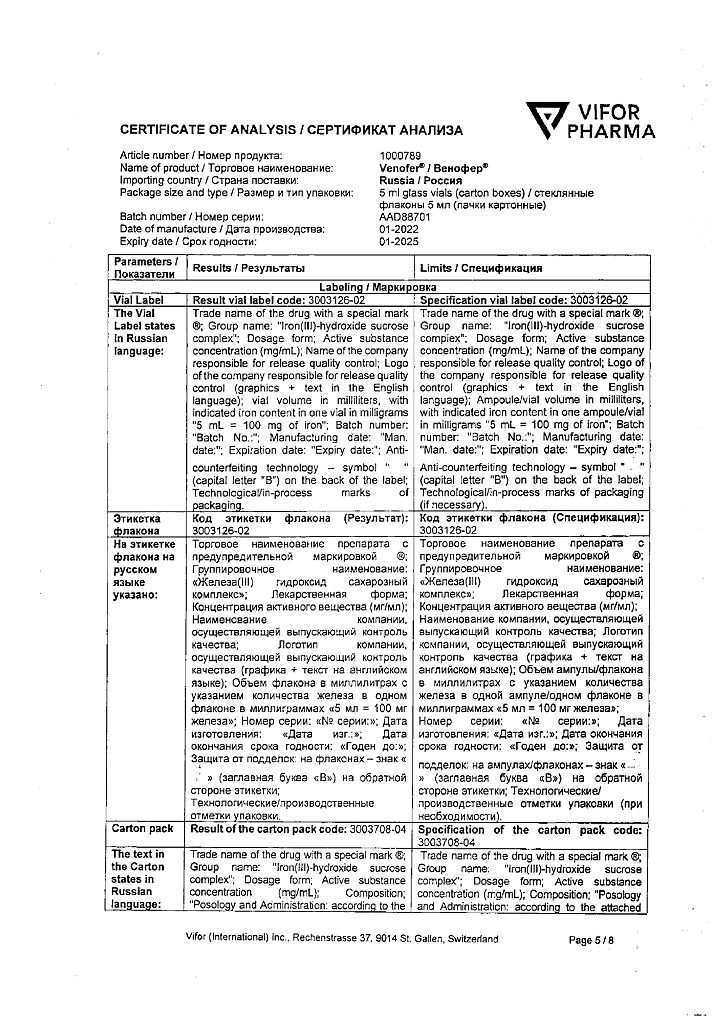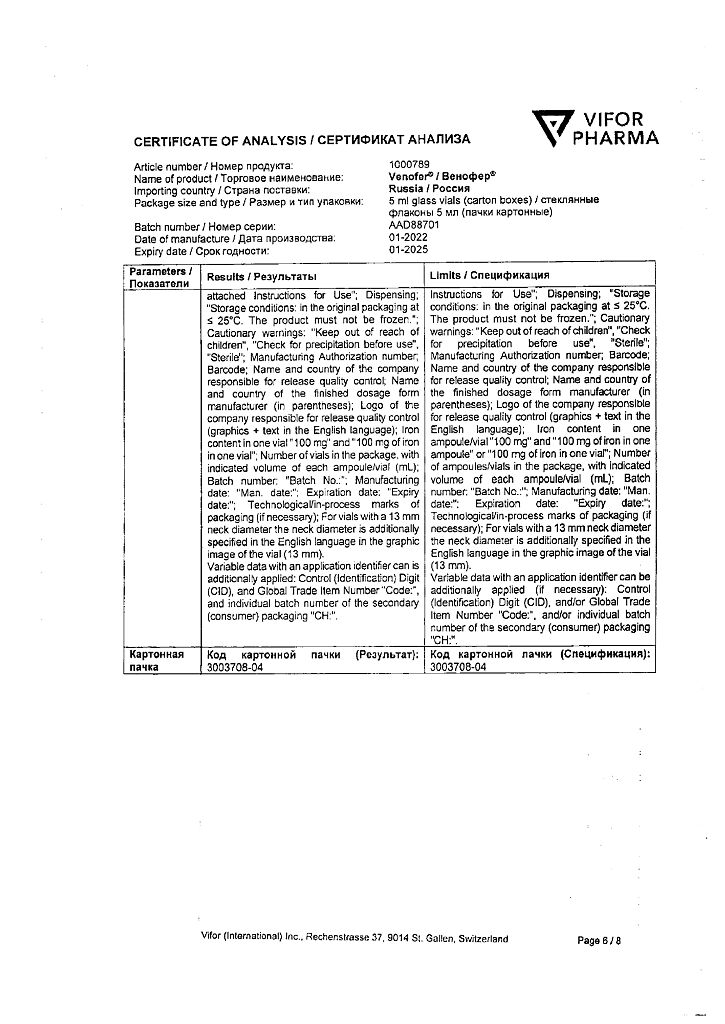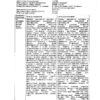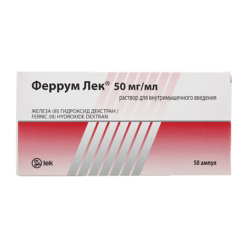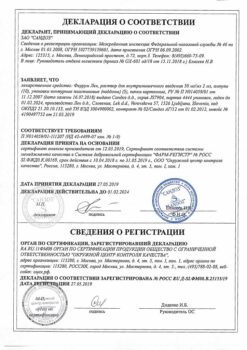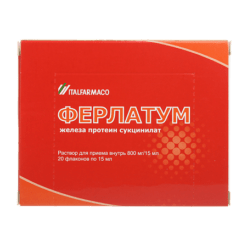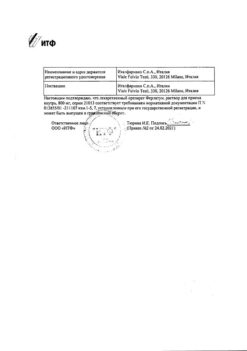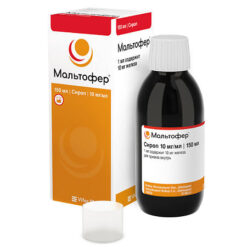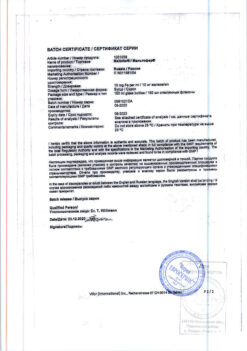No products in the cart.
Venofer, 20 mg/ml 5 ml 5 pcs
€117.41 €101.75
Description
The iron preparation. The multinuclear centers of iron (III) hydroxide are surrounded on the outside by many non-covalently bound sucrose molecules. As a result, a complex is formed with a molecular weight of approximately 43 kD; as a consequence, it cannot be excreted unchanged by the kidneys.
This complex is stable and does not release iron ions under physiological conditions. The iron in this complex is bound to structures similar to natural ferritin.
Pharmacokinetics
Distribution
. After a single intravenous injection of Venofer containing 100 mg of iron, Cmax of iron, averaging 538 μmol, is reached 10 min after injection.
The Vd of the central chamber corresponds almost entirely to the serum volume – about 3 liters.
The Vd in equilibrium is approximately 8 liters (indicating a low distribution of iron in the body fluids).
Due to the low stability of iron sugars compared to transferrin, there is a competitive exchange of iron in favor of transferrin. As a result, about 31 mg of iron (III) is transferred in 24 h.
Elevation
The T1/2 is about 6 h. In the first 4 h, the kidneys excrete less than 5% of iron from total clearance. After 24 h, serum iron levels return to the original (pre-injection) value, and approximately 75% of sucrose leaves the vascular stream.
Indications
Indications
Treatment of iron deficiency conditions in the following cases:
the need to quickly replenish iron deficiency;
in patients who cannot tolerate oral iron supplements or do not comply with treatment;
in the presence of active inflammatory bowel diseases, when oral iron supplements are ineffective.
Pharmacological effect
Pharmacological effect
Iron supplement. The polynuclear iron(III) hydroxide centers are surrounded on the outside by many non-covalently bound sucrose molecules. As a result, a complex is formed, the molecular weight of which is approximately 43 kDa, as a result of which it is impossible to excrete it unchanged by the kidneys.
This complex is stable and does not release iron ions under physiological conditions. The iron in this complex is bound to structures similar to natural ferritin.
Pharmacokinetics
Distribution
After a single intravenous administration of the drug Venofer containing 100 mg of iron, Cmax of iron, on average 538 μmol, is achieved 10 minutes after injection.
The Vd of the central chamber almost completely corresponds to the volume of the serum – about 3 liters.
Vd at steady state is approximately 8 L (which indicates a low distribution of iron in body fluids).
Due to the low stability of iron saccharate compared to transferrin, competitive iron metabolism is observed in favor of transferrin. As a result, about 31 mg of iron (III) is transferred in 24 hours.
Removal
T1/2 – about 6 hours. In the first 4 hours, less than 5% of iron from the total clearance is excreted by the kidneys. After 24 hours, the serum iron level returns to its original (pre-administration) value, and approximately 75% of sucrose leaves the vascular bed.
Special instructions
Special instructions
Venofer should be prescribed only to those patients in whom the diagnosis of anemia is confirmed by appropriate laboratory data (for example, the results of determining serum ferritin or hemoglobin and hematocrit levels, the number of erythrocytes and their parameters – the average volume of an erythrocyte, the average hemoglobin content in an erythrocyte).
Intravenous iron supplements may cause allergic or anaphylactoid reactions, which can be potentially life-threatening.
The rate of administration of Venofer should be strictly observed (with rapid administration of the drug, blood pressure may decrease). A higher incidence of undesirable side effects (especially decreased blood pressure), which can also be severe, is associated with an increase in dose. Thus, the drug administration time given in the “Method of Administration” section must be strictly observed, even if the patient does not receive the drug at the maximum tolerated single dose.
Studies conducted in patients with hypersensitivity reactions to iron dextran showed no complications during treatment with Venofer.
Penetration of the drug into the perivenous space should be avoided, because Venofer entering outside the vessel leads to tissue necrosis and brown discoloration of the skin. If this complication develops, to accelerate the removal of iron and prevent its further penetration into surrounding tissues, it is recommended to apply heparin-containing drugs to the injection site (gel or ointment is applied with light movements, without rubbing).
Shelf life after first opening the container: from a microbiological point of view, the drug should be used immediately.
Shelf life after dilution with saline: chemical and physical stability after dilution at room temperature is maintained for 12 hours. From a microbiological point of view, the solution should be used immediately. If the drug is not used immediately after dilution, the user is responsible for the conditions and storage time, which in any case should not exceed 3 hours at room temperature if the dilution was carried out under controlled and guaranteed aseptic conditions.
Influence on the ability to drive a car and operate machinery. It is unlikely that the drug Venofer may have an undesirable effect on the ability to drive a car and operate machinery.
Active ingredient
Active ingredient
Iron III hydroxide sucrose complex
Composition
Composition
Active ingredient:
iron (III) hydroxide sucrose complex 540 mg (equivalent to iron content 20 mg);
excipients:
sodium hydroxide;
water for injection – up to 1 ml
Pregnancy
Pregnancy
Limited experience with the use of the drug Venofer in pregnant patients has shown the absence of undesirable effects of iron sucrose on the course of pregnancy and the health of the fetus/newborn.
To date, there have been no well-controlled studies in pregnant women.
Animal reproduction studies have shown no direct or indirect harmful effects on embryo/fetal development, parturition or postnatal development.
However, further study of the risk/benefit ratio is required.
It is unlikely that unmetabolized iron sucrose passes into breast milk. Thus, Venofer does not pose a danger to breastfed infants.
Contraindications
Contraindications
hypersensitivity;
anemia not associated with iron deficiency;
signs of iron overload (hemosiderosis, hemochromatosis) or disruption of the process of its utilization;
I trimester of pregnancy.
With caution: bronchial asthma, eczema, polyvalent allergies, allergic reactions to other parenteral iron preparations, low serum iron-binding capacity and/or folic acid deficiency; liver failure, acute or chronic infectious diseases (due to the fact that parenterally administered iron may have an adverse effect in the presence of bacterial or viral infection) and persons with elevated serum ferritin levels.
Side Effects
Side Effects
The following adverse events are currently known to have a temporary and possible causal relationship to the administration of the drug Venofer®. All symptoms were observed very rarely (incidence of occurrence less than 0.01% and greater than or equal to 0.001%).
From the nervous system: dizziness, headache, loss of consciousness, paresthesia.
From the cardiovascular system: palpitations, tachycardia, decreased blood pressure, collapsed states, feeling of heat, flushing of the face, peripheral edema.
From the respiratory system: bronchospasm, shortness of breath.
From the gastrointestinal tract: diffuse abdominal pain, pain in the epigastric region, diarrhea, taste disturbance, nausea, vomiting.
From the skin: erythema, itching, rash, pigmentation disorders, increased sweating.
From the musculoskeletal system: arthralgia, back pain, joint swelling, myalgia, pain in the extremities.
From the immune system: allergic, anaphylactoid reactions, incl. swelling of the face, swelling of the larynx.
General disorders and reactions at the injection site: asthenia, chest pain, feeling of heaviness in the chest, weakness, pain and swelling at the injection site (especially with extravasal ingestion of the drug), feeling of malaise, pallor, fever, chills.
Interaction
Interaction
Venofer should not be prescribed simultaneously with dosage forms of iron for oral administration, because helps reduce iron absorption from the gastrointestinal tract.
Treatment with oral iron supplements can begin no earlier than 5 days after the last injection.
Venofer can be mixed in one syringe only with sterile saline solution.
No other IV solutions or therapeutic agents may be added due to the risk of precipitation and/or other pharmaceutical interactions.
Compatibility with containers made of materials other than glass, PE and PVC has not been studied.
Overdose
Overdose
Overdose can cause acute iron overload, which manifests itself as symptoms of hemosiderosis.
Treatment: It is recommended to use symptomatic agents and, if necessary, iron-binding agents (chelates), such as intravenous deferoxamine.
Storage conditions
Storage conditions
At a temperature of 4–25 °C. In original packaging (do not freeze).
Shelf life
Shelf life
3 years.
Manufacturer
Manufacturer
Vifor (International) Inc., Switzerland
Additional information
| Shelf life | 3 years. |
|---|---|
| Conditions of storage | At a temperature of 4-25 °C. In the original container (do not freeze). |
| Manufacturer | Vifor (International) Inc, Switzerland |
| Medication form | solution |
| Brand | Vifor (International) Inc |
Related products
Buy Venofer, 20 mg/ml 5 ml 5 pcs with delivery to USA, UK, Europe and over 120 other countries.

